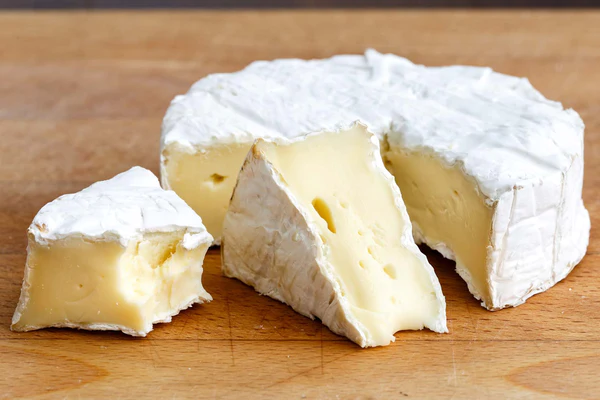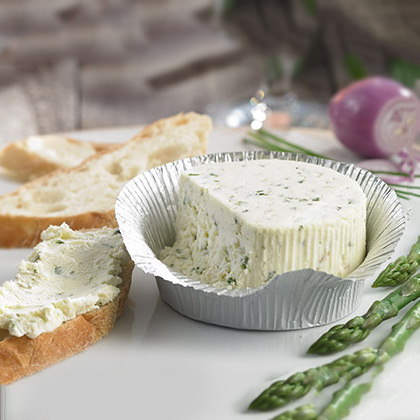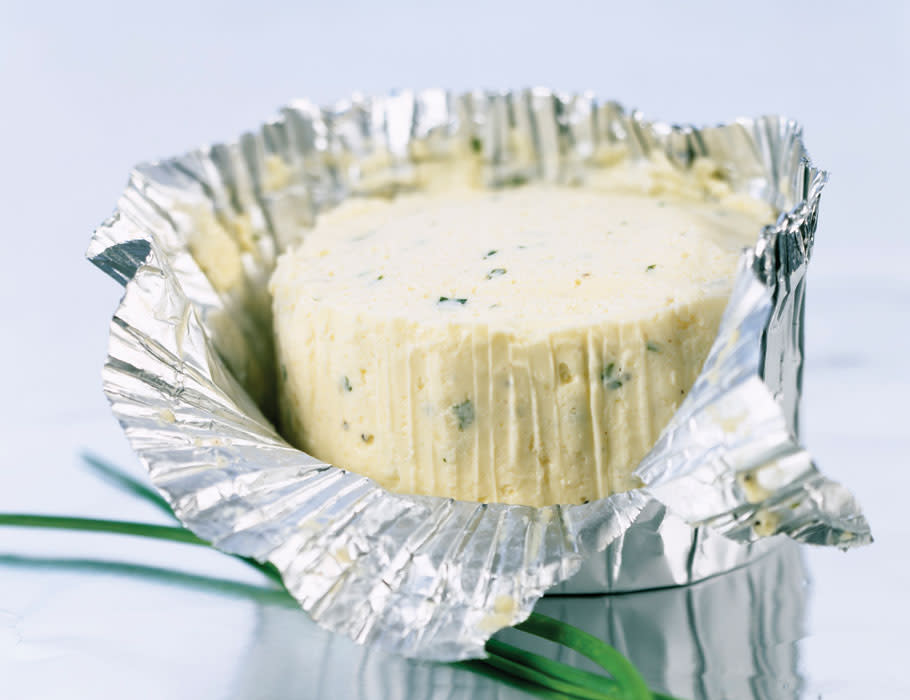What is Boursin Cheese? Unraveling the Magic of Creamy Goodness

This guide is your passport to the enchanting world of Boursin, a cheese that has captivated palates across continents with its creamy, flavorful charm.
Originating from the heart of Normandy in France, this delectable cheese has a rich history and an even richer taste that’s tailor-made for cheese lovers.
An exquisite blend of cream and flavorings, Boursin is a versatile cheese that can transform a simple meal into a culinary masterpiece.
Whether you’re a seasoned cheese connoisseur or a curious foodie looking to explore new flavors, join us as we delve into the magic of Boursin cheese, exploring its origins, variations, pairings, and usage in gastronomic creations.
Quick Facts About Boursin
| Quick Facts | Description |
|---|---|
| Origin | France |
| Milk Source | Cow’s milk |
| Texture | Soft, creamy |
| Flavor | Rich, buttery, and garlicky with various herbs |
| Color | White |
| Aging Process | Not aged |
| Uses | Ideal for spreading on bread, crackers or used in cooking |
| Production Process | The cheese is mixed with garlic and various fine herbs |
What kind of cheese is Boursin?
Boursin is a type of soft, creamy cheese that originates from Normandy, France. It’s made from cow’s milk and is characterized by its rich flavor and crumbly texture. Boursin is derived from a traditional French party dish known as fromage frais.
The cheese is known for its unique blend of savory herbs and spices, which are added to give it a distinct taste. Its flavor and texture are somewhat similar to cream cheese. However, it’s made from Gournay cheese, which is similar to cream cheese but has a more crumbly texture.
Boursin was originally made by François Boursin in 1957, a cheese maker from France. His creation has since become a popular choice for cheese lovers around the world. It’s versatile and can be used in a variety of dishes or served as part of a cheese platter.
Whether spread on bread, used in cooking or enjoyed on its own, Boursin offers a unique and delicious flavor experience that sets it apart from other cheeses.
What does Boursin cheese taste like?
Boursin cheese has a distinct, rich taste that’s a blend of creamy and crumbly textures. It’s known for its buttery flavor with a slight tang, similar to cream cheese.
Boursin comes in a variety of flavors, with herbs and spices mixed into the cheese, adding layers of complexity to its taste.
The most popular variety, Boursin Garlic & Fine Herbs, has a mild yet flavorful garlic taste accompanied by notes of parsley and chives.
The cheese is soft and easily spreadable, making it perfect for crackers, bread, or as a dip. Despite its rich flavor, Boursin has a light, airy texture that melts in your mouth.
Boursin tasting notes
- Texture: Boursin cheese has a unique texture that’s both creamy and crumbly. It’s soft and spreadable, yet retains a certain firmness that gives it structure.
- Color: The cheese is typically white or light cream in color, often speckled with herbs or spices depending on the flavor variety.
- Aroma: Boursin has a fresh, mild aroma. The Garlic & Fine Herbs variety, for example, gives off a subtle scent of garlic, parsley, and chives.
- Taste: At its core, Boursin has a rich, buttery taste with a slight tang, similar to cream cheese but more complex. The flavor intensifies when the cheese is spread and begins to melt in the mouth.
- Flavor Varieties: Boursin comes in several flavor varieties. The Garlic & Fine Herbs variety is mildly garlicky with notes of fresh herbs. Other varieties may include hints of black pepper, shallot, and chive, or cranberry and spice.
- Aftertaste: The aftertaste of Boursin is clean and slightly tangy, leaving a hint of its rich creaminess and herbaceous notes lingering on the palate.
- Pairings: Boursin pairs well with a variety of foods. It’s excellent on crackers or bread, and can also be used as a dip for vegetables. It complements fruits like grapes and apples and pairs beautifully with a glass of white wine or a light beer.
- Culinary Uses: Beyond pairings, Boursin is versatile in the kitchen. It can be used in cooking to enrich sauces, fillings, and toppings, adding a creamy, flavorful element to dishes.
Is Boursin cheese like Brie?
While Boursin and Brie are both soft and creamy cheeses, they have several notable differences.
| Aspect | Boursin | Brie |
|---|---|---|
| Origin | Normandy, France | Île-de-France region, France |
| Milk Source | Cow’s milk | Cow’s milk |
| Texture | Creamy and crumbly, easily spreadable | Soft and creamy, gets runnier as it matures |
| Rind | No rind | Edible bloomy rind |
| Taste | Rich, buttery taste with a slight tang. Comes in various flavors like garlic & herbs, black pepper, shallot & chive | Mild with notes of butter and cream, sometimes hints of mushroom or truffle |
| Pairings | Crackers, bread, vegetables, fruits, white wine, light beer | Bread, fruits, nuts, champagne, medium-bodied red wines |
| Culinary Uses | Can be used in cooking to enrich sauces, fillings, and toppings | Often served at room temperature on cheese boards, also used in baked dishes |
Brie:

Brie is a type of soft, creamy cheese that is traditionally made from cow’s milk. It has a bloomy rind and a creamy center that becomes runnier as it matures. The flavor profile of Brie is mild with notes of butter and cream, and sometimes a hint of mushroom or truffle.
Boursin:

On the other hand, Boursin is a fresh cream and soft cheese, often flavored with herbs and spices. It’s more crumbly compared to Brie and has a rich, buttery taste with a slight tang, similar to cream cheese but more complex due to its variety of flavors. Boursin does not spread on bread as well as cream cheese due to its crumbly texture.
>> Click here to read our in-depth guide on Brie
Why is Boursin cheese so popular?
Boursin’s popularity can be attributed to these 5 factors:
- Unique Flavor and Texture: Boursin offers a unique blend of rich, creamy flavor with a slight hint of tang. It is similar to cream cheese but has a more crumbly texture. The cheese is also often flavored with herbs and spices, adding to its distinct taste.
- Versatility: Boursin is incredibly versatile. It can be spread on bread, used in cooking for enriching sauces or fillings, served as part of a cheese platter, or enjoyed on its own.
- Social Occasions: Boursin has been a part of social occasions and friendly gatherings for over fifty years. It continues to be a popular choice for these events due to its delicious taste and the luxurious experience it offers.
- Origin: Boursin comes from Normandy, France, a region known for its high-quality dairy products. This adds a touch of authenticity and prestige to the brand.
- Brand History: Boursin was created by François Boursin in 1963. The story behind its creation and the longevity of the brand contributes to its popularity.
Do French people eat Boursin?
Yes, French people do eat Boursin cheese. It has become a common household name in the country.
However, it’s important to note that Boursin is not considered a gourmet cheese in France but rather a brand of industrial cheese that is commonly found in supermarkets. It’s often used as a spread or incorporated into dishes, such as in a creamy French omelette.
While Boursin is enjoyed by many in France, it does not hold the same artisanal or traditional prestige as other French cheeses like Camembert or Brie.
Is Boursin healthy?
Boursin cheese, like many other cheeses, can be part of a balanced diet when consumed in moderation.
It’s worth noting that the original Boursin has 40 calories per ounce, which is lower than many other types of cheese, making it a potentially better choice for those watching their calorie intake.
Boursin may not be the healthiest cheese on the market compared to protein-rich options like cottage cheese or cheddar, but there are healthier versions available. For example, Boursin® Dairy-Free Cheese Spread Alternative Garlic & Herbs have similar flavor characteristics but offer a dairy-free alternative.
However, as with any food, the overall health impact of consuming Boursin will depend on individual dietary needs and lifestyle. If you’re concerned about the health implications of eating Boursin or any other cheese, it’s best to consult with a healthcare professional or registered dietitian.
Boursin nutrition facts
| Nutritional Component | Amount (Per 2 tbsp or 29g serving) |
|---|---|
| Calories | 120 |
| Total Fat | 11g |
| Saturated Fat | 7g |
| Cholesterol | 40mg |
| Sodium | 170mg |
| Total Sugars | 1g |
| Protein | Approx 2g (7% of total calories) |
| Carbs | Approx 2g (7% of total calories) |
7 best Boursin substitutes
| Boursin Substitute | Description |
|---|---|
| Goat Cheese | Goat cheese has a unique flavor and creamy texture making it a good stand-in for Boursin. |
| Cottage Cheese | Cottage cheese is mild in flavor and can be mixed with herbs to mimic the taste of Boursin. |
| Neufchâtel Cheese | This cheese is similar in texture to Boursin and has a slightly tangy flavor that can complement many dishes. |
| Fromage Frais | This is a creamy soft cheese from France that can be flavored with herbs to resemble Boursin. |
| Cream Cheese | Cream cheese is smooth and spreadable like Boursin, and it can be flavored to match the taste of Boursin. |
| Beecher’s Handmade Cheese | This artisan cheese is known for its high quality and rich flavor, making it a suitable substitute for Boursin. |
| Laughing Cow Garlic & Herbs | This cheese is also spreadable and comes with a garlic and herb flavor, similar to one of Boursin’s varieties. |
Is Boursin the same as Philadelphia?
Boursin and Philadelphia are not the same, although they both produce cheese products.
| Feature | Boursin | Philadelphia |
|---|---|---|
| Origin | France | United States |
| Type of Cheese | Gournay Cheese | Cream Cheese |
| Texture | Soft and creamy with a crumbly core | Smooth and creamy |
| Flavor Varieties | Garlic & Fine Herbs, Shallot & Chive, Pepper, etc. | Original, Chive & Onion, Garden Vegetable, etc. |
| Usage | Often used in appetizers, as a spread, or in gourmet recipes | Commonly used as a spread, in baking, or in cooking |
| Fat Content (per 2 tbsp serving) | 11g | 10g |
| Calories (per 2 tbsp serving) | 120 | 100 |
Boursin is a French brand known for creating a soft, creamy cheese available in a variety of flavors. Its texture and flavor have been compared to cream cheese, but it’s not identical. Boursin cheese combines classic Gournay Cheese with mouthwatering herbs and spices to create an array of delicate crumbly cheese flavors.
On the other hand, Philadelphia is a brand that primarily produces cream cheese. It’s a popular choice for spreads, baking, and cooking due to its smooth texture and mild flavor.
>> Click here to read our in-depth guide on Cream Cheese
While both cheeses share a similar creamy texture, they differ in flavor profiles and origination. Boursin tends to have a more robust flavor due to the addition of herbs and spices, while Philadelphia cream cheese has a milder, more versatile taste.
What goes well with Boursin? Pairing guide
Food that goes well with Boursin
| Category | Foods |
|---|---|
| Breads | Crostini, Crusty bread, Assorted crackers |
| Proteins | Smoked Salmon, Chicken (as in Enchiladas), Baked Boursin (similar to Baked Brie) |
| Vegetables | Corn on the cob, Spinach, Mushroom |
| Fruits | Seasonal fruits |
| Snacks & Sides | Olives, Nuts, Jacket potato, Fries topped with Boursin whipped through yogurt |
| Sauces | White wine sauce mixed with Boursin |
| Desserts | Recipes incorporating Boursin |
Also read: 11 Best Crackers that Pair Well with Cheese
Beverage that goes well with Boursin
| Category | Beverages |
|---|---|
| Wine | Chardonnay, Sauvignon Blanc, Pinot Noir |
| Beer | Belgian-style ales, Pilsner, Wheat beer |
| Non-Alcoholic | Sparkling water, Apple cider, Herbal tea |
Also read: Best Wine and Cheese Pairings: The Ultimate Guide
The History of Boursin

Boursin cheese has a rich history that dates back to 1957. It was created by François Boursin, a cheesemaker from Normandy, France. Inspired by a long-standing tradition in which guests choose their own seasonings to add to their fresh cream cheese, François decided to create a unique product that offered a variety of flavors already mixed into the cheese.
His first creation was Boursin Garlic & Fine Herbs, which quickly became popular in France. The cheese was actually the first of its kind to be advertised on television in 1968, with the memorable slogan, “Du pain, du vin, du Boursin” (Bread, wine, and Boursin).
The brand continued to grow and expand internationally over the following decades. Today, Boursin is known for its distinct flavor and creamy, crumbly texture. Its range has expanded to include a variety of flavors such as Shallot & Chive, Pepper, and more.
Despite its growth, Boursin has maintained its quality, using only the best ingredients to create its cheeses. The brand continues to be a staple in many households, loved for its versatility and gourmet taste.
Frequently Asked Questions
1. Is Boursin goat or cow cheese?
Boursin is made from cow’s milk, not goat’s milk.
2. Is Boursin basically cream cheese?
While Boursin and cream cheese share some similarities, they are not the same. Both are soft, spreadable cheeses that are often used in similar ways, such as in dips or spreads. However, their flavors and textures are different.
Boursin is a Gournay cheese, a type of cheese that’s soft and crumbly in nature and can be flavored with a variety of herbs, spices, and other ingredients.
Cream cheese, on the other hand, is a fresh cheese with a mild, slightly tangy flavor. It’s incredibly smooth and creamy, and it’s often used as a base for other flavors in recipes like cheesecake or frosting.
3. Is Boursin a good substitute for cream cheese?
Yes, Boursin can be used as a substitute for cream cheese in many dishes. Its rich, creamy texture and distinct flavor can add a unique touch to recipes that typically use cream cheese. However, it’s worth noting that Boursin has a stronger, more garlicky flavor compared to the mild, slightly tangy flavor of cream cheese.
4. Do I need to refrigerate Boursin?
Yes, Boursin cheese should be refrigerated. After opening, it can be stored in the refrigerator for up to two weeks when kept in an airtight container. However, if your Boursin is unopened, it should last up to four weeks past the printed date on the packaging when properly stored in the fridge.
It’s also recommended to use clean utensils when serving Boursin cheese to avoid contamination that could shorten its shelf life.
Also read: What’s the Best Way to Store Cheese?
5. What does Boursin mean in English?
“Boursin” doesn’t have a direct translation in English as it is a brand name. It’s named after its creator, François Boursin, who was a cheese maker from Normandy, France.
Also read:
- The Ultimate Guide to Basket Cheese: An Easter Delight
- All About Swiss Cheese: A Comprehensive Guide
- The Tale of Taleggio: Unveiling Italy’s Pungent Treasure
- Cotswold Cheese: A Taste of England’s Finest
- The Ultimate Guide to Hoop Cheese: A Southern Delight
- The Ultimate Guide to Chèvre: Exploring Goat Cheese
- Fior di Latte: A Comprehensive Guide to Italy’s Creamy Delight





